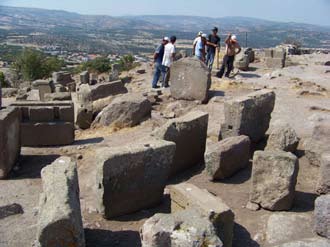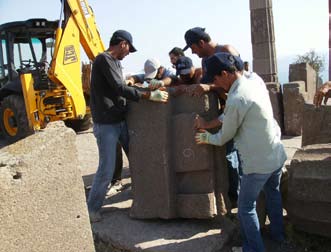November 15, 2008
Temple of Athena at Assos 2008 Report
by Nurettin Arslan
Download article (PDF)
A report on the restoration and new presentation of the site
Introduction
Towering impressively over the sea, the temple of Athena at Assos is a magnet for tourists from all over the world. Its design and construction, which date to ca. 530 B.C., also make it a key monument for our understanding of Greek temple architecture. The ruins of the temple were made even more prominent, however, in the 1980s, when missing parts of the stylobate were replaced and a total of five columns re-erected using some of the original architectural members. Since then, the temple has become a highly frequented tourist destination. Similar to other reconstructed temples (e.g. Temple of Poseidon at Cape Sounion, Temple of Athena at Lindos/Rhodes or the so called Temple of Concordia at Agrigento), the Temple of Athena at Assos obviously caters to the romantic ideal of a lonesome ruin picturesquely embedded in the surrounding landscape.
Until very recently, however, both appearance and preservation of the temple were unsatisfying in many respects: the five reconstructed columns had been re-erected by using several drums made of steel-reinforced concrete, which began to show severe defects several years ago. Their surface has partly broken away and the corroding steel reinforcements have generated considerable cracks in their surface. Without appropriate counter measures, the modern column drums will continue to disintegrate and will soon also endanger the stability of the columns. Similar deficiencies are also apparent in the area around the temple. After several excavation campaigns during the last 120 years, the temple’s many large architectural members are haphazardly scattered around the site, partly lying upon each other and partly covered by earth.
Some fragments have fallen down the slopes of the acropolis, and many have broken during the last few years.
The 2008 Field Season
In August 2008, a restoration project was begun with the following goals:
- Large architectural members (columnar drums, capitals, cornice blocks) are being surveyed, salvaged, and systematically ordered according to a system of inventory numbers developed earlier by Professor Bonna Wescoat of Emory University. This allows us to identify and preserve the elements that are newly discovered or were thought to have been lost.
- The columnar anastylosis needs to be maintained as the site’s most prominent feature. The decaying concrete drums of the present restoration, however, are replaced by pieces in stone. While modeled after the preserved originals, different surface treatments enable a clear differentiation between ancient original and modern restoration. Investigation of the extant drums not used in the current restoration has shown that the anastylosis of a further columnar shaft is impossible. In any case, an additional re-erected column would neither improve the site’s appearance nor be a scientific gain.
- The figural reliefs that originally decorated the temple’s architraves and metopes are a unique feature of the temple’s design and should thus be made accessible to the site’s visitors. Therefore it is projected to reconstruct a part of the entablature (equal to the width of 1-2 columnar axes) by using actual architectural members (capitals, triglyphs, cornice blocks) and plaster casts of the reliefs currently in the Archaeological Museum in Istanbul.
All together, this project aims at preserving the temple’s original remains while making this unique and all-important archaeological site more intelligible for the visitor.
Three weeks of fieldwork in August and September 2008 allowed us to take the following measures for reorganizing the appearance of the temple and its surrounding area:
- Architectural members at and near the acropolis were located, and some buried fragments were uncovered and put in an upright position.
- Attribution of the architectural fragments was much enhanced by the support of Professor Wescoat whose publication of this material is forthcoming. Wescoat was kind enough to provide her unpublished inventory lists, which contain numbers, most important measurements, as well as the find spots of 150 extant fragments. The majority of the architectural members could thus be identified and studied.
- Thanks to the community of Behramkale,which provided a construction vehicle, it was possible to begin reorganization of the entire archaeological site. Concrete blocks lying on the Acropolis since the last restoration were removed and many architectural members of the temple were transported to a suitable place. The largest and most significant cornice blocks were rearranged on the foundations of the cella.
- The new on-site arrangement of architectural members has already yielded important study results: some cornice blocks that had been recarved to be used in the tympanon are now placed in such a way that their original function becomes clear to the visitor.
- All damaged concrete drums of the columns were measured in preparation for a subsequent restoration of the columns.
- Finally, the area previously occupied by architectural members was cleaned so that it is now ready for further investigation.
A Look Ahead
The campaign in 2009 will focus on:
- Completing the relocation of architectural members; the cornice fragments will be organized in a sort of “Lapidarium” in the interior of the temple while other pieces will be situated at suitable places on the acropolis.
- Restoration of the three columns at the temple’s south side; experienced masons will replace deficient concrete pieces by architectural members carved from local trachyte stone. The new columnar drums in stone will be marked in order to be distinguishable from the ancient drums.
The goal of this project is to make the acropolis of Assos more attractive and more informative to the visitor, while guaranteeing appropriate conservation of the ruin. Moreover, it will provide a basis for further investigations of the area around the temple and the entire acropolis. The support of the Archaeological Institute of America is thus fundamental for both making the rich ancient heritage of the acropolis of Assos accessible to the public in a responsible way and fostering archaeological research of the site.
Dr. Nurettin Arslan
Director of the Assos Excavations
Onsekiz Mart University, Canakkale, Turkey
Download article (PDF)


